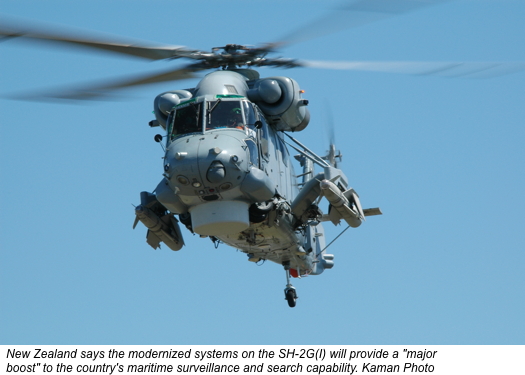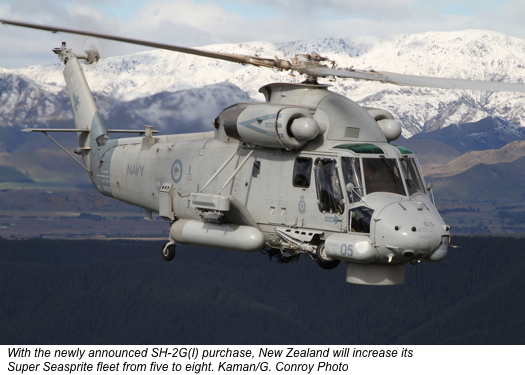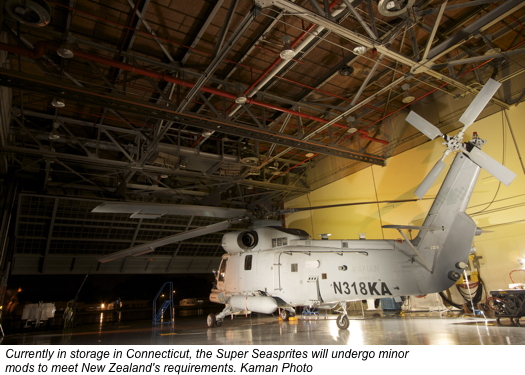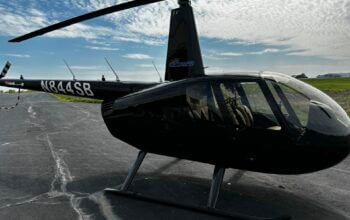
In a deal worth $120 million US, New Zealand will purchase the Kaman SH-2G(I) Super Seasprites originally built for — and rejected by — the Australian Defence Force.
The New Zealand Cabinet has authorized the New Zealand Ministry of Defence (MoD) to enter into a contract with Kaman for the purchase of 10 SH-2G(I) Super Seasprite helicopters, spare parts, a full mission flight simulator and related logistics support. The MoD and Kaman expect to execute a contract in the next few weeks. They anticipate the contract will call for the aircraft to be delivered over an approximately three-year period, with revenue recognition beginning in 2013 and the first three aircraft due in New Zealand in late 2014.
Neal J. Keating, Kaman Corp. president and CEO, called the deal “an important step forward for Kaman,” noting that the New Zealand Defence Force has been operating the Super Seasprite successfully for more than a decade. “This success led to their interest in our SH-2G(I), the latest variant of the aircraft and one of the most technologically advanced helicopters in the world today,” he stated in a press release. “We welcome the opportunity to continue supporting the operational needs of the New Zealand Defence Force.”
The deal includes eight operational aircraft that will replace New Zealand’s five existing Seasprites, plus two spare airframes. According to New Zealand Defence Minister Jonathan Coleman, the fleet expansion will “ensure that our naval fleet is able to operate at its full potential,” allowing helicopters to be embarked on two ANZAC-class frigates (Te Mana and Te Kaha) as well as offshore patrol vessels and the multi-role ship HMNZS Canterbury. He added the new SH-2G(I)s’ modernized sensor, weapons and flight control systems will be “a major boost” to the country’s maritime surveillance and search capability.

Kaman has been attempting to sell the Seasprites since 2009, when the Australian Defence Force cancelled its billion-dollar contract for the refurbished former United States Navy aircraft amid doubts about their ability to meet Australia’s requirements. According to the New Zealand MoD, a key issue was that the Australian Defence Force specified an aircraft that could be flown by a two-person crew and have a computer flight system that could operate the aircraft with no hands on the controls. Attempts to add this sophisticated computer controlled flight operating system led to a series of delays, project management issues, and cost over-runs.
The New Zealand Defence Force, however, does not have this “no hands” requirement, and will operate the SH-2G(I)s with a crew of three. The New Zealand MoD said all other technical issues with the aircraft have been resolved by Kaman, which continued to further develop the aircraft after Australia cancelled the contract.
“The New Zealand Defence Force and Ministry of Defence officials are acutely aware that the Australian government decided not to fully introduce these aircraft into service after concerns about a range of technical issues,” said Coleman. “As a consequence the New Zealand Ministry of Defence has invested considerable resources into examining all aspects of this project over the last two years. This included commissioning an independent study by Marinvent Corporation of Canada. Ministry of Defence officials have advised the government this aircraft will prove a very capable purchase, meet all of the New Zealand Defence Force’s requirements, and can be introduced into service.”
What’s more, he said, “the price is very good, with alternative helicopter replacements costing three times the amount.”
The Super Seasprites are currently in storage in Connecticut, and will need to be returned to flying condition. The New Zealand MoD said they will undergo some minor modifications to meet the country’s requirements, and the Defence Force will undertake the usual airworthiness and certification process in preparation for operational flying. The country will incur additional costs for testing and introduction into service activities, ship decklock modification, additional components and Penguin missiles, anti-ship missiles on the SH-2G(I) that are more advanced than the general-purpose Maverick missiles on New Zealand’s existing Seasprites.










